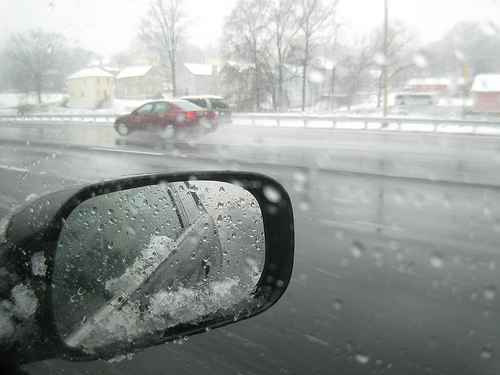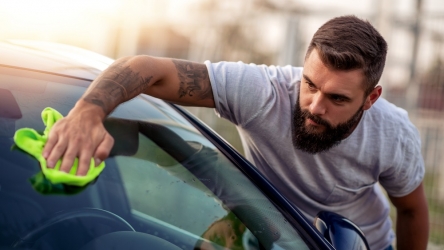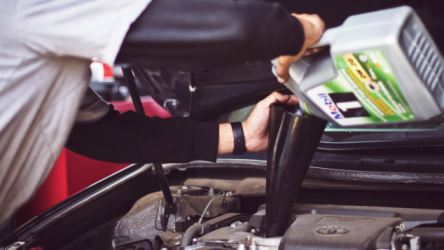
With the winter season here, you could find yourself needing to navigate the roads in dangerous weather. Although it’s preferable to stay inside and not have to deal with the roads, sometimes you have no choice in the matter.

Here are 6 tips to help you stay in control of your vehicle out in the ice and snow.
Snow Plows
While you’re out driving on the slick, snow-covered roads, there’s a good chance you’ll come across a snow plow or a sanding truck. If you do, don’t pass those vehicles, even if they’re going slower than you’d like to.
Snow plows have lower visibility than regular vehicles, so they might not see you trying to pass them. Not only that, but the roads in front of the snow plow haven’t been plowed, so you’ll end up driving on a road even more dangerous than the one you’re already on. Don’t risk getting in an accident any more than you are by simply being out on the streets during a storm.
Speed
The most important thing to remember when driving in a winter storm or on icy roads is to slow down. If you think your car can handle slick or icy roads, think again. Maybe you have four-wheel drive or snow tires, but neither one of these means that you have any more control on black ice than a regular car. You will still slide, and if you’re going too fast, you’re more likely to get into an accident.
You should also avoid using cruise control. Even if you’re using it to keep your speed down in the poor road conditions, cruise control is just as dangerous as going too fast. If you hit ice or water on the roadway, your car will try to keep the set speed, and you’ll be more likely to lose control of the car.
Following Distance
Tailgating on icy roads is far more dangerous than tailgating on dry roads. If you get into a fender-bender on icy roads, you’ll end up on the side of the road with cars all around you slipping and sliding. One of them could end up hitting your car, causing even more serious injuries.
Therefore, make sure that you increase your following distance from about 2-3 seconds behind the car in front of you to 8-10 seconds. Give yourself plenty of room and time to stop should you need to.
Stops
Stopping your car on icy roads can be difficult if you don’t know what you’re doing. The first thing to keep in mind is to start slowing down early. If you have anti-lock brakes, maintain a steady pressure on the brakes, but don’t push too hard. If you don’t have ABS, pump the brakes gently.
Make sure to keep your brake pads in good condition so your car will have what it needs to keep you safe. You don’t want anything to happen to them, resulting in any number of costly things like hydraulic repair or a hospital visit because you couldn’t stop in time.
Try not to come to a complete stop if you can help it. It’s harder to get going from a full stop than it is from a rolling stop, so if you can roll slowly toward a street light or in traffic, do it.
Headlights
When you’re driving in a snow storm or even just out in the snow and ice, always use your headlights. They not only give you visibility, but they also let other drivers know another car is nearby, even if they can’t see the car. If it’s snowing, make sure to keep your beams low, because high beams will whiteout the road in front of you, blinding you.
Hills
Navigating hills, whether uphill or downhill, is one of the more dangerous scenarios when it comes to driving on icy roads. It’s easy to get stuck or lose control of your vehicle if you don’t do it correctly.
If you’re trying to go uphill, gain your momentum before you start up the incline because, odds are, you’re not going to have any traction to speed up on the hill. Don’t apply the brakes on the uphill stretch; if you slow down at all, you probably won’t make it up.
If you’re heading downhill, slow down before you descend. Try not to use your brakes if you don’t have to; although if it’s a longer hill, you might have to tap them every once in a while. Coast as much as you possibly can. That way, you’ll be more likely to stay in control of your vehicle.
Winter driving is rarely something anyone wants to do, but by following these tips, you can be sure to stay as safe as possible if you have to hit the roads this winter season.
Featured images:
License: Creative Commons
image source
License: Creative Commons image source
Author byline:
Eloise Hamilton studied political science and now writes primarily about politics and thought, and her other love—cars. From tires to transmissions, she loves learning everything she can about repair jobs and upgrades, and she frequents sites like Star Tires LTD. Aside from cars and Congress, her interests include photography and cooking.







